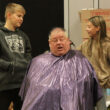Sean C. Morgan
As part of Wildland Fire Awareness Month, the Oregon Department of Forestry and Keep Oregon Green are urging people to be cautious when burning backyard debris.
While cleaning up the yard, chipping or recycling are recommended, but burning is an option.
“Only burn plant materials,” said Neil Miller, ODF Sweet Home Unit Forest Protection Supervisor. Burn piles should not include plastics, rubber or anything that isn’t a plant or wood product. Paper should be contained so it doesn’t fly up from the fire.
“Call before you burn,” Miller said. “It seems like every year, we get a few folks burning when they shouldn’t.”
Often they’re new to the community and claim they didn’t know, Miller said. Typically, fire officials will give them a warning. A second visit will usually result in a citation and a $110 fine.
A ban on backyard burning usually begins mid-June and lasts until the end of fire season typically in mid-October.
Sometimes, a fire will escape a burn pile.
“We average three to four a year where we actually have to take action on it,” Miller said. Usually, that’s followed by law enforcement action.
Burn complaints are one of the most common complaints, Miller said. Nine out of 10 times, they’re already out by the time ODF officials arrive.
The ODF does allow recreational fires, for a family reunion, for example, Miller said, but those require a waiver from the Sweet Home Unit on ODF-protected land.
When planning to burn, Miller said, call the burn line (541) 451-1904 after 8:30 a.m. every day you wish to burn. Follow the instructions and note the information in the message.
Prior to burning, mow around the pile if needed. Have a shovel and water available. Watch the pile until the burning material is consumed and the fire is completely out.
An adult, 18 years or older, must be in direct view of the fire at all times. The burn pile should be at least 50 feet from a structure.
The ground around the pile should be scraped in a 5- to 10-foot radius to prevent the fire from spreading. Extra caution should be taken on windy days, avoiding burning at all if possible.
Fire should not be near tall grass or power lines, and burning should be done early in the morning or in the evening when humidity is the highest and wind is lowest. Never use gasoline or other accelerants to start a fire.
The pile should be small enough to control at all times.
Any fire you ignite is your responsibility, and you are liable for any damages caused by that fire. In 2013, the ODF spent more than $190,000 on fires caused by debris burning.
Escaped debris fires are the leading cause of wildfires in Oregon.
Fire danger appears to be higher than usual due to lack of snow during the winter, based on the most recent projections, Miller said. Fire danger will reach critical levels in southeast and southwest Oregon in June.
From July to August, the chance of fire appears above normal in Southern Washington and the Mid-Valley.
El Nino is setting in, Miller said, and that brings drier summer weather patterns. Precipitation will likely be below normal and temperatures will be higher than normal.
Total rainfall for the year remains higher than last year, Miller said. The Sweet Home Unit has measured 1.8 inches so far in May.




